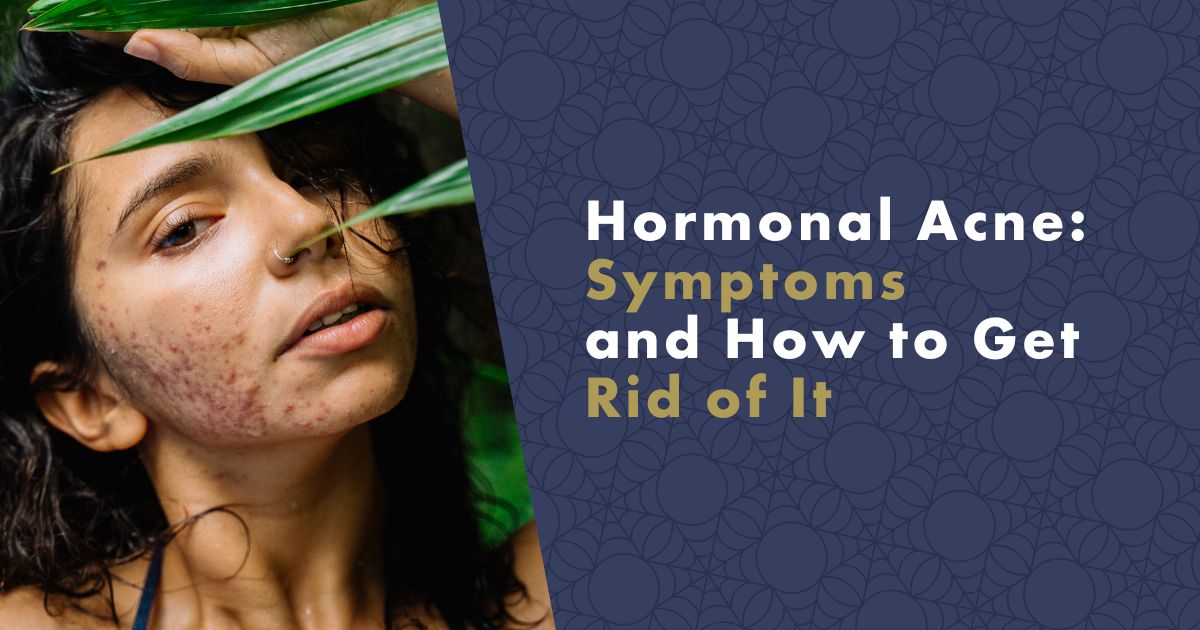Hormonal acne is a type of acne associated with hormonal changes in the body. It mainly affects women during puberty, pregnancy, menstruation, or menopause. Although women are more prone to this issue, hormonal acne can also trouble men. In this article, we'll delve into why hormonal acne occurs, what it looks like, and how to effectively get rid of it.

How to Recognize Hormonal Acne?
Hormonal acne is a type of acne resulting from hormone imbalance, specifically elevated levels of androgens or male sex hormones. This form of acne can occur in both men and women during adolescence and adulthood. It typically appears in areas with high concentrations of sebaceous glands, so you'll find hormonal acne on the chin, face, cheeks, and jawline. Symptoms of hormonal acne include:
- Pimples – Pimples need no introduction. They are painful raised spots with a red hue that gradually fill with pus.
- Blackheads – While not as large as pimples, blackheads are abundant on the face. Pores become clogged with sebum and darken upon exposure to air.
- Whiteheads – Whiteheads are also indicative of clogged pores. However, since they remain closed, they retain their white appearance.
- Papules – Red raised spots without pus may be another sign of hormonal acne. These solid, inflamed bumps are called papules.
- Pustules – When the condition of a typical pimple worsens, pustules form. They are larger than pimples because they contain more pus.
- Cysts – While common acne vulgaris may manifest in various rash types, hormonal acne often presents as deep, painful cysts, which are also typical of subcutaneous acne. These cysts are caused by excessive sebum production, which clogs pores and leads to P. acnes bacteria proliferation.

Tip: Not sure how to tackle acne? Try 10 effective tips to get rid of acne.
What Causes Hormonal Acne?
Hormonal acne often occurs due to changes in the levels of certain hormones, such as estrogen, progesterone, and androgens (especially testosterone). These changes can occur at various stages of life:
- Adolescence and puberty - During this period, there is an increase in androgen levels, which can lead to inflammation and increased sebum production.
- Menstrual cycle - Women, in particular, may experience hormonal acne in adulthood. Fluctuations in estrogen and progesterone levels during the menstrual cycle can increase the likelihood of acne development.
- Pregnancy - Pregnancy involves significant hormonal changes, which may be associated with acne occurrence.
- Menopause - During menopause, there is a decrease in estrogen levels and an increase in testosterone levels.
- Polycystic ovary syndrome (PCOS) - Women with this syndrome may have elevated androgen levels, increasing the risk of acne development.
- Stress - Stress often increases cortisol levels. Subsequently, there is increased sebum production and acne formation.
Several other factors that may significantly influence the development of hormonal acne cannot be overlooked. Some individuals may have a greater predisposition to acne formation from birth, i.e., genetic predisposition. Lifestyle also often plays a role. Incorrect dietary composition, lack of sleep, and physical activity lead, among other things, to hormonal imbalance, which, as you now know, paves the way for hormonal acne.
Tip: What helps with menstrual pain? Read in another article.
Hormonal Acne: Treatment
How to treat hormonal acne? A visit to a dermatologist is definitely not out of the question. When it comes to hormonal acne, it's important to control hormone levels, such as estradiol, progesterone, or testosterone, and you simply can't manage that without professional care.
Treatment of hormonal acne may consist of hormone therapy, medications to reduce androgen levels, or removal of inflammation and excess sebum in the skin. The most common treatment for hormonal acne involves combined hormonal contraceptive preparations containing two types of hormones – estrogen and progesterone.
This form of treatment can be really effective because estrogens, through the induction of SHBG synthesis, reduce the level of free androgens in the blood and thus improve the course of hormonal acne. However, sometimes it may be necessary to combine hormonal treatment with other medications for hormonal acne (such as retinoids or antibiotics) to achieve optimal results.
#produkty#https://www.nanospace.store/against-acne/
Tip: Adult Acne and What Works for It. Read on the blog.
What Helps with Hormonal Acne?
To prevent hormonal acne or at least minimize its impact, it's important not only to follow the doctor's recommendations but also to take proper care of your skin and your entire body. Since hormonal acne most commonly manifests as inflammatory papules, pustules, and cysts, we've prepared a few tips for you that, combined with medical advice, can lead to their treatment and subsequent prevention.
Skin Cleansing
Regular, gentle cleansing and moisturizing of the skin twice a day helps reduce excessive sebum production and minimize inflammation. Use skincare products designed for problematic skin and avoid chemicals or exfoliating agents that may irritate the skin.
There are plenty of products on the market for hormonal acne, so it's easy to reach for the wrong one. Below is a list of ingredients that effective skincare for hormonal acne should contain:
- Salicylic Acid – Salicylic acid contributes to acne reduction and prevents pore clogging. It penetrates well into deeper layers of the skin and helps other active ingredients penetrate more easily.
- Oil – Since salicylic acid is not soluble in water but in fats, skincare for hormonal acne should contain some oil. The best is almond oil, which doesn't clog pores.
- Niacinamide (Vitamin B3) – Niacinamide can help reduce inflammation and redness associated with hormonal acne while strengthening the skin's protective barrier.
- Hyaluronic Acid – Hyaluronic acid's task is to hydrate the skin, which is crucial in treating hormonal acne.
- Retinol – Retinol promotes faster skin cell turnover. Creams containing it should be used at night because it's not ideal for retinol to come into contact with sunlight.

Tip: How Do Acne Patches Work and Which Ones Are Best? Find out in the article.
We have a simple tool for you on how to care for skin with hormonal acne. Use a day cream in the morning, a night cream in the evening. Always read how to use the cream, though. For example, Acne Cream NAFIGATE is ideal for fighting hormonal acne. It contains natural ingredients that hydrate the skin but don't clog pores. However, you should use it for one week and then skip the next week to prevent the skin from building resistance to the active ingredients it contains.
TIP: Best Acne Products: Navigating the World of Skincare
Dietary Changes
Some studies have shown that a diet rich in healthy fats, fiber, and antioxidants can have a positive effect on the skin and help reduce the risk of developing hormonal acne. Avoid foods high in sugars and starches, which can increase insulin levels and worsen acne. Here are a few tips on what to include in your diet:
- Omega-3 fatty acids – Consuming fish such as salmon, tuna, and mackerel, as well as flaxseed and nuts, helps fight inflammation in the body and improve skin condition.
- Fruits and vegetables – A diet rich in fruits and vegetables provides your skin with important vitamins and antioxidants that help reduce inflammation.
- Foods with a low glycemic index – Fast sugars and foods with a high glycemic index often lead to excessive sebum production and thus the development of hormonal acne. Avoid sweets, white bread, and potatoes. Opt for foods with a low glycemic index, including whole grains, oats, and legumes.
- Water – Adequate water intake is important for hydrating the skin and flushing toxins from the body.
- Zinc – Zinc helps reduce inflammation and promote acne healing. You can find it in beef and chicken, nuts, and legumes.
- Green tea – Green tea contains polyphenols that have anti-inflammatory effects and help with skin redness and swelling.
Dietary Supplements
Increase your intake of vitamins and minerals. Try dietary supplements, as they can also help treat hormonal acne. Thanks to dietary supplements, you can provide your body with the right amount of what it needs, because sometimes diet alone is not enough. Focus mainly on dietary supplements containing zinc and vitamin D.
Also, avoid stress and ensure you get enough sleep, which can be aided by magnesium. And don't forget to incorporate regular exercise into your life. You'll see that by adjusting your lifestyle, you'll achieve positive results that aren't just related to hormonal acne.
#produkty#https://www.nanospace.store/search/?string=collagen
Tip: Read on the blog, what helps with back acne.
Frequently Asked Questions
Where does hormonal acne occur?
Hormonal acne mainly occurs on the chin, face, cheeks, and jawline.
What really works for acne?
In addition to medically recommended treatment, skincare products work for hormonal acne. Skincare for hormonal acne should contain salicylic acid, almond oil, hyaluronic acid, Niacinamide, and Retinol. Treat your skin with a day cream in the morning, and opt for a night cream in the evening.
How to get rid of acne overnight?
You won't get rid of hormonal acne overnight. You can alleviate its course with a night cream.
How to speed up acne healing?
Skincare for hormonal acne, dietary changes, and dietary supplements can help with healing.
What dietary supplements are suitable for hormonal acne?
Dietary supplements containing vitamin D, zinc, and magnesium are suitable for hormonal acne. These substances support the proper functioning of the immune system and contribute to improving skin condition.
At what age does acne disappear?
It's not possible to generalize at what age hormonal acne disappears in a person. Hormonal acne can occur not only during adolescence but also in adulthood, when the body undergoes hormonal changes (such as menstrual cycle, pregnancy, menopause). Your doctor will advise you on how to get rid of hormonal acne during that period.
Is it common to suffer from hormonal acne in adulthood?
Yes, hormonal acne is not limited to adolescence but can also occur in adults. Fluctuations in hormone levels, such as during menstruation or in stressful situations, can lead to the development of hormonal acne.
How to get rid of hormonal acne on the back?
To alleviate hormonal acne on the back, use gentle shower gels or those specifically designed for hormonal acne. Also, make changes to your diet, consume dietary supplements rich in vitamin D, zinc, and magnesium. Also, wear breathable clothing made of materials that wick away sweat.
Sources
- SHAW, James C. Acne: effect of hormones on pathogenesis and management. American journal of clinical dermatology, 2002, 3: 571-578.
- KAMANGAR, Faranak; SHINKAI, Kanade. Acne in the adult female patient: a practical approach. International Journal of Dermatology, 2012, 51.10: 1162-1174.
- THIBOUTOT, Diane. Acne: hormonal concepts and therapy. Clinics in dermatology, 2004, 22.5: 419-428.
- O'CONNELL, Katharine; WESTHOFF, Carolyn. Pharmacology of hormonal contraceptives and acne. Cutis, 2008, 81.1: 8.
- GEORGE, Rosalyn; CLARKE, Shari; THIBOUTOT, Diane. Hormonal therapy for acne. In: Seminars in cutaneous medicine and surgery. WB Saunders, 2008. p. 188-196.

